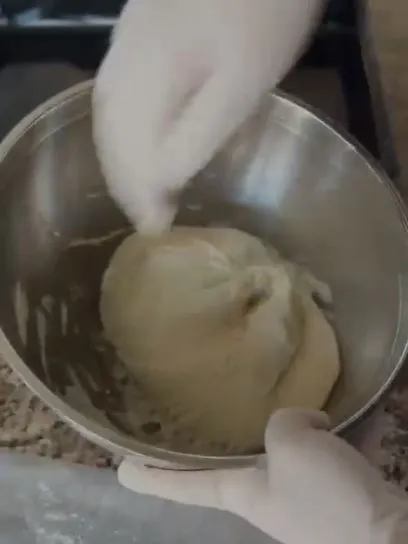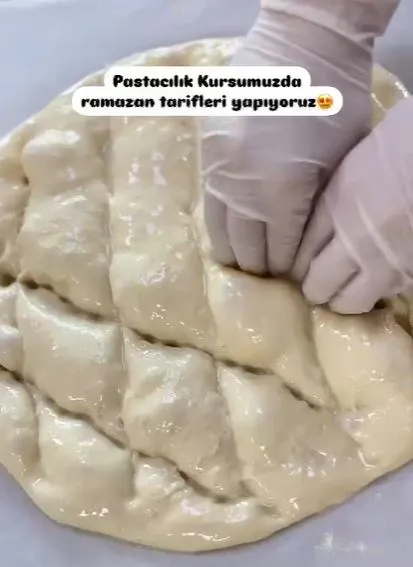Sharing, Being Together: Abundance in Hearts with Ramadan Pide
At Çayırova Public Education Center in Turkey, the traditional delicacy of "Ramadan Pide" making, especially during Ramadan, was conducted as part of the "Pide Making" course. These courses aim to help the public gain knowledge and skills about traditional flavors.
Pide Making Course at Public Education Centers, Including Ramadan Pide Making
- Course Objective: The aim of the Ramadan pide making course is to teach participants traditional Ramadan pide recipes, correct usage of materials, and techniques, allowing them to make this traditional delicacy at home. Additionally, these courses serve as a cultural transmission, encouraging the correct preparation of pide as part of the Ramadan tradition.
- Course Content: The content of the Ramadan pide making course typically includes the following topics:
- Material Knowledge: Correct selection and use of essential ingredients like flour, yeast, salt, water, and sesame used in pide making.
- Dough Preparation and Kneading Techniques: Correctly kneading the pide dough to the right consistency, allowing it to rise, and shaping it.
- Pide Baking Techniques: Key points for properly baking pide in the oven, controlling temperature, baking time, and ensuring the pide's characteristic fluffiness.
- Shaping the Pide: Creating the traditional pide shape and sprinkling sesame or nigella seeds on top.
- Social and Cultural Aspects: The cultural significance of Ramadan pide, its place at the table during Ramadan, and its societal meaning.
- Course Duration and Program: Ramadan pide courses at Public Education Centers are usually short-term. These courses can be offered before or during the Ramadan month. The course duration may vary depending on the participants' skill levels. A typical course duration ranges from 1-2 weeks, with a program that may include:
- 2-3 Days per Week: 2-3 hours of lessons.
- Lessons: Both theoretical information and practical baking lessons.
- Instructors and Methods: In Ramadan pide making courses, instructors are typically experienced chefs, bakers, or culinary experts. They teach both theoretical knowledge and practical skills to participants. As the courses are hands-on, participants experience each step and learn by doing. Additionally, instructors may also demonstrate different types of pide alongside traditional recipes.
- Course Participants: Those wishing to participate in courses at Public Education Centers typically include:
- Housewives,
- Individuals who want to learn how to cook,
- Those interested in making pide at home during Ramadan,
- Those who have an interest in traditional flavors. Participants can be from any age group, and the courses are available for both individual and group participation.
- Certificate and Afterward: At the end of the course, successful participants are usually awarded a certificate by the Public Education Center. This certificate serves as official proof of the training and can be useful for those working in the food industry or wishing to start their own business at home.
- Social Activity and Sharing: Ramadan pide courses also serve as social events. Participants come together during the traditional Ramadan pide making process, share experiences, and strengthen societal solidarity. These courses play an important role in not only teaching cooking skills but also in preserving and sharing a culture.
Conclusion
Ramadan pide courses held at Public Education Centers allow for the preservation of traditional cuisine and the correct preparation of this special bread that is a staple during Ramadan. These courses help participants develop both practical skills and a deeper understanding of the cultural value of Ramadan pide. These courses are important educational activities that enhance manual skills, preserve traditional values, and foster social connections within the community.
Ramadan pide is a special type of bread traditionally made during Ramadan, dating back to the Ottoman Empire, and has become an indispensable part of iftar tables. This pide holds great historical and cultural significance, not only for its taste but also as a symbol of solidarity, unity, and religious values in society.
The History of Ramadan Pide
The history of Ramadan pide dates back to the Ottoman Empire. In the Ottoman period, bread was one of the most preferred foods on the iftar tables of those fasting during Ramadan. However, the belief that this bread should be made in a special way during Ramadan led to the creation of Ramadan pide. It is thought that Ramadan pide, as part of traditional Ottoman cuisine, is associated with charitable meals and communal iftar gatherings during Ramadan.
Its Importance Worldwide
Ramadan pide is not only prepared in Turkey but also in various regions around the world during the Ramadan month, each in different forms. However, bread-like variations of Ramadan pide hold an important place in many regions. In the Middle East, North Africa, and South Asia, special breads are also prepared during Ramadan, but each of these has unique characteristics. For example, in Egypt, a pastry called "fatair" and in Indonesia, varieties of "roti" are commonly found on Ramadan tables. However, Ramadan pide is unique as a symbol of Ramadan traditions in Turkey.
Its Importance and Traditional Development in Turkey
In Turkey, Ramadan pide is especially made in bakeries during Ramadan, and as iftar time approaches, the warm pides coming out of the ovens become the most important part of every table in neighborhoods. Although it is baked in different ways in every village, town, and city of Turkey, each version essentially symbolizes unity, cooperation, and hospitality.
Preparing and Serving Pide: Ramadan pide is specially prepared and traditionally made from yeast dough. Basic ingredients such as wheat flour, water, salt, and yeast are used. After the dough rises, it is shaped into a round form, and sesame is sprinkled on top. The pide, baked in the oven, creates a special atmosphere for iftar with its aroma and warmth
.Cultural and Social Aspect: Ramadan pide, beyond being a food item, represents a traditional value that carries the spirit of Ramadan. During Ramadan, while the bakeries prepare special pides for the public, the bakers also build a close relationship with the people. Those waiting in line to buy pide experience this tradition as a social event. Furthermore, taking warm pide to homes is also an example of social cooperation.
Special Shape and Texture: The special shape of Ramadan pide, along with its soft texture and lightly yeasted flavor, makes it a beloved feature during Ramadan. It is served at tables alongside traditional sahur and iftar foods such as cheese, olives, and olive oil. In some regions, sesame or nigella seeds, unique to Turkish cuisine, are sprinkled on the pide, enhancing its flavor.
The Social Meaning of Ramadan Pide
Ramadan pide is not just a food item, but also a symbol of Ramadan culture in Turkey. By sharing their pides during Ramadan, people strengthen their relationships with neighbors, remember the importance of cooperation, and experience the joy of performing the religious act of fasting together. In this sense, pide is seen as a tool that encourages solidarity and sharing among people.
Conclusion
Ramadan pide holds an important place both historically and culturally. This special bread, which has survived from the Ottoman period to the present day, is more than just a food; it has become a symbol reflecting the spiritual atmosphere of the Ramadan month. In every village, town, and city of Turkey, this tradition is kept alive. As Ramadan arrives, bakeries are specially prepared, and tables are adorned with this traditional delicacy.









